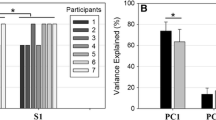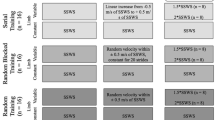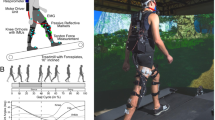Abstract
This study aimed to determine whether inter-individual differences in learning rate of a novel motor task could be predicted by movement variability exhibited in a related baseline task, and determine which variability measures best discriminate individual differences in learning rate. Thirty-two participants were asked to repeatedly complete an obstacle course until achieving success in a dual-task paradigm. Their baseline gait kinematics during self-paced level walking were used to calculate stride-to-stride variability in stride characteristics, joint angle trajectories, and inter-joint coordination. The gait variability measures were reduced to functional attributes through principal component analysis and used as predictors in multiple linear regression models. The models were used to predict the number of trials needed by each individual to complete the obstacle course successfully. Frontal plane coordination variability of the hip-knee and knee-ankle joint couples in both stance and swing phases of baseline gait were the strongest predictors, and explained 62% of the variance in learning rate. These results show that gait variability measures can be used to predict short-term differences in function between individuals. Future research examining statistical persistence in gait time series that can capture the temporal dimension of gait pattern variability, may further improve learning performance prediction.



Similar content being viewed by others
Abbreviations
- SD:
-
Standard deviation
- 1MET:
-
1st metatarsal head
- 5MET:
-
5th metatarsal head
- MAL:
-
Malleoli
- CAL:
-
Calcaneus
- FEM:
-
Femoral condyle
- ASIS:
-
Anterior superior iliac spine
- PSIS:
-
Posterior superior iliac spine
- IC:
-
Iliac crest
- GT:
-
Greater trochanter
- SAC:
-
L4/L5 inter-vertebral space
- TC:
-
Thigh cluster
- SC:
-
Shank cluster
- CA:
-
Coupling angle
- CAV:
-
Coupling angle variability
- PCA:
-
Principal component analysis
- PC:
-
Principal component
- PCR_StrideChar:
-
Multiple linear regression model using the principal components from stride characteristic variability measures only
- PCR_StanceKin:
-
Multiple linear regression model using the principal components from stance phase kinematic variability measures only
- PCR_SwingKin:
-
Multiple linear regression model using the principal components from swing phase kinematic variability measures only
- PCR_Overall:
-
Overall regression model using predictors that were selected by a step-wise regression model which included principal components from all three gait variability models
- Initial_Time:
-
Trial completion time on the first obstacle course trial
- R2 :
-
Explained variance
- PC1_StrideChar:
-
First principal component of the principal component analysis that used stride characteristics only
- PC2_StrideChar:
-
Second principal component of the principal component analysis that used stride characteristic variability measures only
- PC1_StanceKin:
-
First principal component of the principal component analysis that used stance phase kinematic variability measures only
- PC2_StanceKin:
-
Second principal component of the principal component analysis that used stance phase kinematic variability measures only
- PC3_StanceKin:
-
Third principal component of the principal component analysis that used stance phase kinematic variability measures only
- PC1_SwingKin:
-
First principal component of the principal component analysis that used swing phase kinematic variability measures only
- PC2_SwingKin:
-
Second principal component of the principal component analysis that used swing phase kinematic variability measures only
- PC3_SwingKin:
-
Third principal component of the principal component analysis that used swing phase kinematic variability measures only
References
Bartlett, R., J. Wheat, and M. Robins. Is movement variability important for sports biomechanists? Sports Biomech. 6:224–243, 2007.
Berry, S. D., and R. F. Thompson. Prediction of learning rate from the hippocampal electroencephalogram. Science 200:1298–1300, 1978.
Bradshaw, E. J., P. S. Maulder, and J. W. Keogh. Biological movement variability during the sprint start: performance enhancement or hindrance? Sports Biomech 6:246–260, 2007.
Burgess, P. Movement cues are necessary for load stabilization against low friction. Neuroscience 15:173, 1989.
Butler, R. J., J. D. Willson, D. Fowler, and R. M. Queen. Gender differences in landing mechanics vary depending on the type of landing. Clin J Sport Med 23:52–57, 2013.
Carpenter, M., C. Murnaghan, and J. Inglis. Shifting the balance: evidence of an exploratory role for postural sway. Neuroscience 171:196–204, 2010.
Cazzola, D., G. Pavei, and E. Preatoni. Can coordination variability identify performance factors and skill level in competitive sport? The case of race walking. J Sport Health Sci 5:35–43, 2016.
Chao, E. Y. Justification of triaxial goniometer for the measurement of joint rotation. J Biomech 13:989–1006, 1980.
Diedrich, F. J., and W. H. Warren, Jr. Why change gaits? Dynamics of the walk-run transition. J Exp Psychol 21:183, 1995.
Ducharme, S. W., J. J. Liddy, J. M. Haddad, M. A. Busa, L. J. Claxton, and R. E. van Emmerik. Association between stride time fractality and gait adaptability during unperturbed and asymmetric walking. Hum Mov Sci 58:248–259, 2018.
Efron, B., and R. Tibshirani. Bootstrap methods for standard errors, confidence intervals, and other measures of statistical accuracy. Stat Sci 1(1):54–75, 1986.
Freedman Silvernail, J., R. E. van Emmerik, K. Boyer, M. A. Busa, and J. Hamill. Comparisons of segment coordination: an investigation of vector coding. J. Appl. Biomech. 20:1–6, 2018.
Gabell, A., and U. Nayak. The effect of age on variability in gait. J. Gerontol. 39:662–666, 1984.
Grood, E. S., and W. J. Suntay. A joint coordinate system for the clinical description of three-dimensional motions: application to the knee. J. Biomech. Eng. 105:136–144, 1983.
Haken, H., J. S. Kelso, and H. Bunz. A theoretical model of phase transitions in human hand movements. Biol. Cybernet. 51:347–356, 1985.
Hamill, J., J. M. Haddad, and W. J. McDermott. Issues in quantifying variability from a dynamical systems perspective. J. Appl. Biomech. 16:407–418, 2000.
Hausdorff, J. M. Gait dynamics, fractals and falls: finding meaning in the stride-to-stride fluctuations of human walking. Hum. Mov. Sci. 26:555–589, 2007.
Hausdorff, J. M., H. K. Edelberg, S. L. Mitchell, A. L. Goldberger, and J. Y. Wei. Increased gait unsteadiness in community-dwelling elderly fallers. Arch Phys Med Rehabil 78:278–283, 1997.
Heiderscheit, B. C. Movement variability as a clinical measure for locomotion. J. Appl. Biomech. 16:419–427, 2000.
Heiderscheit, B. C., J. Hamill, and R. E. A. van Emmerik. Variability of stride characteristics and joint coordination among individuals with unilateral patellofemoral pain. J. Appl. Biomech. 18:110–121, 2002.
Herzfeld, D. J., and R. Shadmehr. Motor variability is not noise, but grist for the learning mill. Nat. Neurosci. 17:149, 2014.
Jordan, K., J. H. Challis, J. P. Cusumano, and K. M. Newell. Stability and the time-dependent structure of gait variability in walking and running. Hum. Mov. Sci. 28:113–128, 2009.
Kincses, Z. T., H. Johansen-Berg, V. Tomassini, R. Bosnell, P. M. Matthews, and C. F. Beckmann. Model-free characterization of brain functional networks for motor sequence learning using fMRI. Neuroimage 39:1950–1958, 2008.
Konig, N., N. B. Singh, J. von Beckerath, L. Janke, and W. R. Taylor. Is gait variability reliable? An assessment of spatio-temporal parameters of gait variability during continuous overground walking. Gait Posture 39:615–617, 2014.
Latash, M. L., J. P. Scholz, and G. Schoner. Motor control strategies revealed in the structure of motor variability. Exerc. Sport Sci. Rev. 30:26–31, 2002.
Li, L., J. M. Haddad, and J. Hamill. Stability and variability may respond differently to changes in walking speed. Hum. Mov. Sci. 24:257–267, 2005.
Maki, B. E. Gait changes in older adults: predictors of falls or indicators of fear? J. Am. Geriatr. Soc. 45:313–320, 1997.
Marx, R. G., T. J. Stump, E. C. Jones, T. L. Wickiewicz, and R. F. Warren. Development and evaluation of an activity rating scale for disorders of the knee. Am. J. Sports Med. 29:213–218, 2001.
McGrath, D., M. Patterson, U. M. Persson, and B. Caulfield. Frontal-plane variability in foot orientation during fatiguing running exercise in individuals with chronic ankle instability. J. Athel. Train. 52:1019–1027, 2017.
Preatoni, E., M. Ferrario, G. Dona, J. Hamill, and R. Rodano. Motor variability in sports: a non-linear analysis of race walking. J. Sports Sci. 28:1327–1336, 2010.
Riccio, G. E. Information in movement variability about the qualitative dynamics of posture and orientation. In: Variability and motor control, edited by K. M. Newell, and D. M. Corcos. Champaign, Ill: Human Kinetics, 1993, pp. 317–357.
Sandlund, J., D. Srinivasan, M. Heiden, and S. E. Mathiassen. Differences in motor variability among individuals performing a standardized short-cycle manual task. Hum. Mov. Sci. 51:17–26, 2017.
Sasaki, M. Observations on micro-exploration in everyday activities. Stud. Percept. Action III:99–102, 1995.
Sparrow, W. A., E. Donovan, R. Vanemmerik, and E. B. Barry. Using relative motion plots to measure changes in intra-limb and inter-limb coordination. J. Motor Behav. 19:115–129, 1987.
Srinivasan, D., T. Rudolfsson, and S. E. Mathiassen. Between- and within-subject variance of motor variability metrics in females performing repetitive upper-extremity precision work. J. Electromyogr. Kinesiol. 25:121–129, 2015.
Tabachnick, B. G., and L. S. Fidell. Using multivariate statistics. Boston: Pearson Education, 2013.
Tomassini, V., S. Jbabdi, Z. T. Kincses, R. Bosnell, G. Douaud, C. Pozzilli, P. M. Matthews, and H. Johansen-Berg. Structural and functional bases for individual differences in motor learning. Hum. Brain Mapp. 32:494–508, 2011.
Wilson, C., S. E. Simpson, R. E. A. Van Emmerik, and J. Hamill. Coordination variability and skill development in expert triple jumpers. Sports Biomech. 7:2–9, 2008.
Wu, Y.-H., and M. L. Latash. The effects of practice on coordination. Exerc. Sport Sci. Rev. 42:37, 2014.
Wu, H. G., Y. R. Miyamoto, L. N. G. Castro, B. P. Ölveczky, and M. A. Smith. Temporal structure of motor variability is dynamically regulated and predicts motor learning ability. Nat. Neurosci. 17:312, 2014.
Wurdeman, S. R., N. B. Huben, and N. J. J. O. B. Stergiou. Variability of gait is dependent on direction of progression: implications for active control. J. Biomech. 45:653–659, 2012.
Young, A. J., and D. P. Ferris. State of the art and future directions for lower limb robotic exoskeletons. IEEE Trans. Neural Syst. Rehabil. Eng. 25:171–182, 2017.
Yu, B. Effect of external marker sets on between-day reproducibility of knee kinematics and kinetics in stair climbing and level walking. Res. Sports Med. 11:209–218, 2003.
Yu, B., C.-F. Lin, and W. E. Garrett. Lower extremity biomechanics during the landing of a stop-jump task. Clin. Biomech. 21:297–305, 2006.
Zeni, Jr, J., J. Richards, and J. Higginson. Two simple methods for determining gait events during treadmill and overground walking using kinematic data. Gait Posture 27:710–714, 2008.
Zwick, W. R., and W. F. Velicer. Comparison of five rules for determining the number of components to retain. Psychol. Bull. 99:432, 1986.
Acknowledgments
The authors would like to acknowledge the contributions of Melanie Kangelaris and Willow Ruud for their assistance with data collection and processing.
Conflict of interest
No benefits in any form have been or will be received from a commercial party related directly or indirectly to the subject of this manuscript.
Author information
Authors and Affiliations
Corresponding author
Additional information
Associate Editor Jane Grande-Allen oversaw the review of this article.
Publisher's Note
Springer Nature remains neutral with regard to jurisdictional claims in published maps and institutional affiliations.
Rights and permissions
About this article
Cite this article
Ulman, S., Ranganathan, S., Queen, R. et al. Using Gait Variability to Predict Inter-individual Differences in Learning Rate of a Novel Obstacle Course. Ann Biomed Eng 47, 1191–1202 (2019). https://doi.org/10.1007/s10439-019-02236-x
Received:
Accepted:
Published:
Issue Date:
DOI: https://doi.org/10.1007/s10439-019-02236-x




